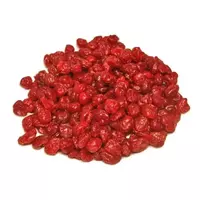Cured cherries

Cherry is a fairly common berry in our country, where it is grown almost everywhere. Small berries attract our attention with their rich dark red, unforgettable slightly tart taste and pleasant aroma. Depending on the variety, the cherries may differ in color and size. There are, for example, the most real giants that are not inferior to cherries, but you can also find completely miniature berries. The same goes for cherry colour, which ranges from pale yellow to maroon, almost black.
In cooking, cherries have found widespread use and have become one of many people's favorite treats. It can be consumed both fresh and recycled. Jams, compotes, liqueurs, jam, marmalade and homemade cherry wines are very popular. In addition, there is another way to prepare this fragrant berry - drying. Cured cherries are just a godsend for cooking, as this fragrant product adds a unique touch to the finished dish.
It is worth noting that store dried cherries are a rather expensive treat, so many housewives have learned to harvest this berry at home. The process, one might say, is quite long and a little tedious, but it definitely pays off more than that. In addition, cured cherries retain most of the beneficial properties of fresh berries.
Thanks to just a fantastic aroma, cured cherries are used in a wide variety of dishes: pastries, sauces, desserts, drinks. Winter pastries are very successful, for example, pies with stuffing, in which dried cherries were added. And what are Easter cakes and Christmas muffins, the aroma of which just dizzy and immediately appears festive mood!
cured cherries 293 kCal
Energy value of cured cherries (Ratio of proteins, fats, carbohydrates - ju):
Proteins: 1.5 g (~ 6 kCal)
Fats: 0 g (~ 0 kCal)
Carbohydrates: 73 g (~ 292 kCal)
Energy ratio (bj | y): 2% | 0% | 100%
 Español
Español Français
Français Português
Português Русский
Русский 简体中文
简体中文 繁體中文
繁體中文 日本語
日本語 한국어
한국어 العربية
العربية Türkçe
Türkçe Қазақ
Қазақ Deutsch
Deutsch Italiano
Italiano Українська
Українська
